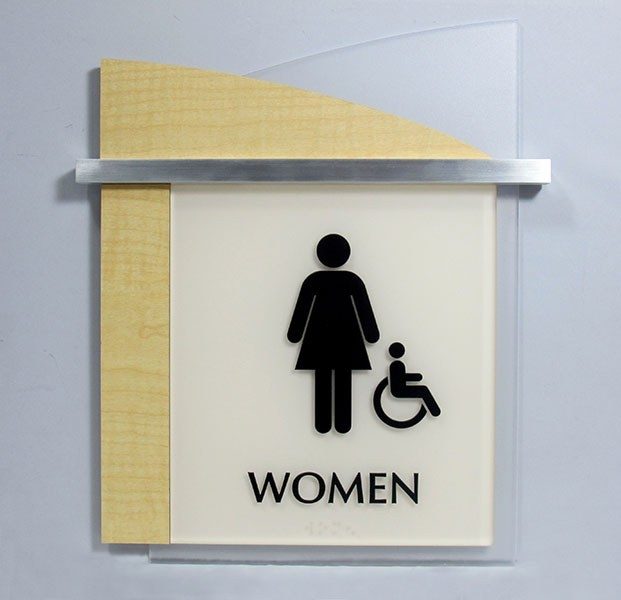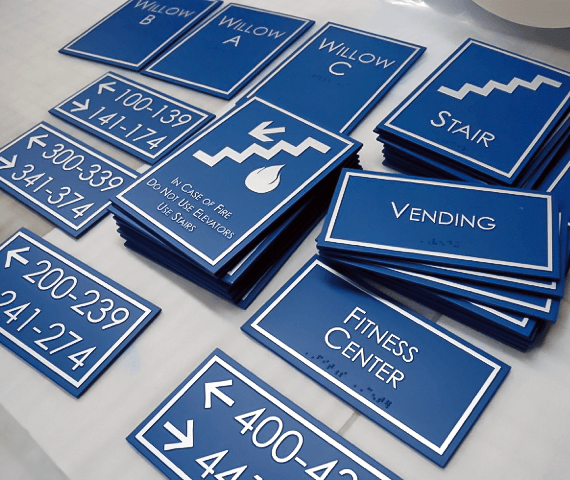Discovering Imaginative Layouts for Reliable ADA Signs
Discovering Imaginative Layouts for Reliable ADA Signs
Blog Article
Checking Out the Secret Functions of ADA Indications for Boosted Access
In the world of accessibility, ADA indicators offer as quiet yet effective allies, making certain that spaces are navigable and comprehensive for people with handicaps. By integrating Braille and tactile components, these signs damage barriers for the visually damaged, while high-contrast color pattern and legible typefaces satisfy varied aesthetic requirements. Their critical positioning is not arbitrary yet instead a computed initiative to promote seamless navigation. Yet, past these features exists a much deeper story concerning the advancement of inclusivity and the recurring dedication to creating fair rooms. What more could these indications indicate in our quest of universal access?
Significance of ADA Compliance
Making certain compliance with the Americans with Disabilities Act (ADA) is crucial for fostering inclusivity and equivalent gain access to in public rooms and offices. The ADA, enacted in 1990, mandates that all public facilities, employers, and transport services accommodate individuals with handicaps, ensuring they enjoy the very same legal rights and possibilities as others. Conformity with ADA standards not just fulfills legal responsibilities however also improves an organization's credibility by showing its dedication to diversity and inclusivity.
One of the key aspects of ADA compliance is the execution of easily accessible signage. ADA signs are designed to ensure that people with specials needs can easily browse with rooms and structures.
Furthermore, adhering to ADA laws can alleviate the danger of possible fines and lawful consequences. Organizations that stop working to follow ADA standards may encounter fines or suits, which can be both monetarily difficult and damaging to their public picture. Thus, ADA conformity is indispensable to cultivating an equitable atmosphere for everyone.
Braille and Tactile Aspects
The consolidation of Braille and tactile elements into ADA signs personifies the principles of access and inclusivity. These functions are crucial for individuals who are aesthetically impaired or blind, enabling them to browse public rooms with greater self-reliance and self-confidence. Braille, a tactile writing system, is essential in supplying created information in a style that can be conveniently viewed through touch. It is normally positioned beneath the corresponding text on signs to make certain that individuals can access the info without visual aid.
Tactile components prolong beyond Braille and include increased personalities and signs. These elements are developed to be discernible by touch, allowing individuals to recognize space numbers, bathrooms, departures, and other crucial areas. The ADA establishes certain guidelines concerning the dimension, spacing, and positioning of these responsive aspects to optimize readability and make certain uniformity across different environments.

High-Contrast Color Design
High-contrast color design play a crucial function in enhancing the presence and readability of ADA signage for individuals with aesthetic impairments. These systems are vital as they make best use of the distinction in light reflectance between message and background, making certain that signs are easily noticeable, also from a distance. The Americans with Disabilities Act (ADA) mandates the usage of certain shade contrasts to suit those with minimal vision, making it a vital aspect of compliance.
The efficiency of high-contrast colors hinges on their capability to stand out in different lights conditions, including poorly lit settings and areas with glare. Commonly, dark text on a light history or light text on a dark history is used to achieve ideal comparison. For example, black text on a white or yellow history provides a stark visual distinction that helps in fast acknowledgment and comprehension.

Legible Fonts and Text Dimension
When thinking about the style of ADA signs, the option of readable typefaces and appropriate text dimension can not be overemphasized. The Americans with Disabilities Act (ADA) mandates that font styles should be sans-serif and not italic, oblique, script, extremely decorative, or of unusual kind.
The dimension of the message also plays a critical role in ease of access. According to ADA standards, the minimal message elevation need to be 5/8 inch, and it must enhance proportionally with viewing range. This is particularly essential in public spaces where signage demands to be checked out quickly and precisely. Consistency in message dimension adds to a cohesive aesthetic experience, helping individuals in browsing environments efficiently.
In addition, spacing in between letters and lines is essential to readability. Adequate spacing prevents personalities from appearing crowded, enhancing readability. By sticking to these criteria, designers can significantly boost access, guaranteeing that signs serves its designated objective for all individuals, despite their visual capacities.
Effective Positioning Approaches
Strategic placement of ADA signage is vital for taking full advantage of access and guaranteeing conformity with lawful requirements. Properly positioned indications assist people with disabilities successfully, facilitating navigation in public spaces. Key considerations include closeness, height, and exposure. ADA guidelines state that indicators should be placed at an elevation in between 48 to 60 inches from the ground to ensure they are within the line of sight for both standing and seated individuals. This conventional height array is crucial for inclusivity, allowing wheelchair customers and individuals of varying heights to access details effortlessly.
Furthermore, indicators have to be put beside the latch side of doors to allow very easy recognition before access. This positioning helps people view it now locate spaces and spaces without blockage. In situations where there is no door, signs should be situated on the closest adjacent wall. Uniformity in indication positioning throughout a center enhances predictability, lowering complication and improving general user experience.

Verdict
ADA indicators play a vital role Recommended Site in promoting accessibility by incorporating functions that resolve the needs of people with disabilities. These elements jointly cultivate a comprehensive setting, underscoring the significance of ADA compliance in ensuring equivalent gain access to for all.
In the world of access, ADA indications serve as silent yet powerful allies, guaranteeing that areas are navigable and inclusive for individuals with disabilities. The ADA, passed in 1990, mandates that all public centers, companies, and transport services suit people with disabilities, guaranteeing they enjoy the same civil liberties and possibilities as others. ADA Signs. ADA indications are developed to guarantee that people with disabilities can conveniently navigate via areas and structures. ADA standards stipulate that indicators should be placed at a height in between 48 to 60 inches from the ground to ensure they are within the line of sight for both standing and seated people.ADA indicators play an important duty in advertising ease of access by incorporating attributes that attend to the needs of people with disabilities
Report this page